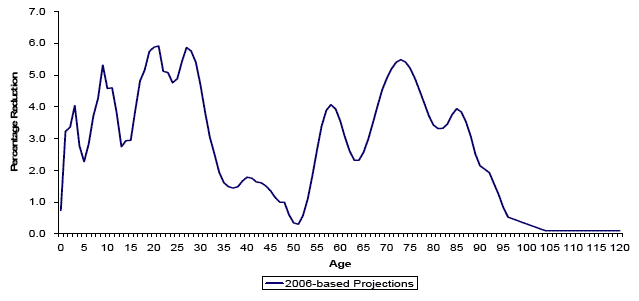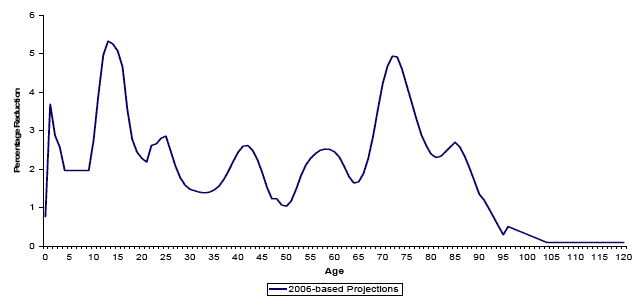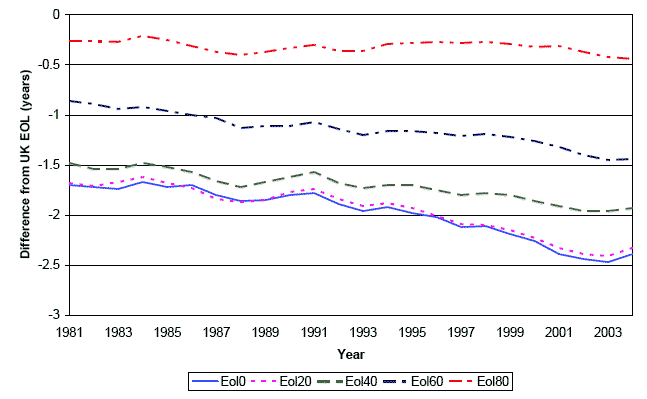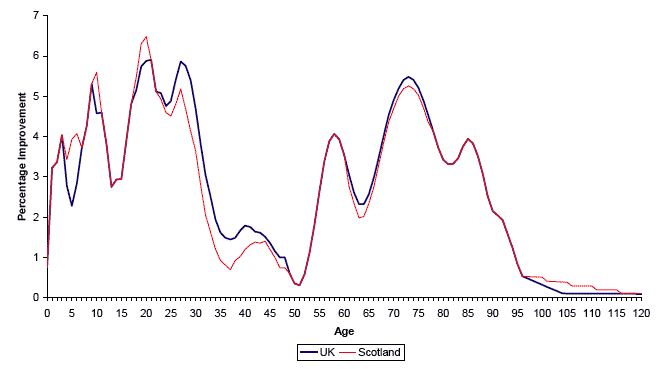
The mortality rates for the first year of the projection, mid-2006 to mid-2007, are based on the best estimates that could be made in the autumn of 2007 of the numbers of deaths at each age in 2006-07.
Assumed improvements in mortality rates after 2006-07 are based on trends in mortality rates before 2006. Improvements in mortality rates by age and gender in the base year of the projection are estimated from the trends in years from 1961 to 2005. It is assumed that annual rates of mortality improvement will converge to a common rate of 1.0 per cent a year at 2031 for most ages, and continue to improve at that constant rate thereafter. However, it is assumed that those born in the years 1923 to 1940 (cohorts which have consistently experienced relatively high rates of mortality improvement over the last 25 years) will continue to experience higher rates of mortality improvement until they die, with assumed rates of improvement in and after 2031 rising from 1.0% a year for those born before 1923 to a peak of 2.5% a year for those born in 1931 and then declining back to 1.0% a year for those born in 1941 or later. In the 2004-based projections it was assumed that these cohort differentials would disappear over time with a common rate of improvement of 1.0 per cent assumed at all ages by 2029.
The rates of mortality improvement which are assumed for the UK for the base year of the projections (2006-07) are shown in Figure B1 below.
Figure B1 Projected smoothed reductions in death rates by age, UK 2006-2007
Males

Females

A comparison of period expectations of life (eols) for Scotland with the UK as a whole (Figure B2) suggests there has been a gradual widening in the difference in expectations of life for males under the age of 80, since the early-1980s. There are no obvious patterns of divergence (or convergence) in the comparison of Scottish and UK life expectancies for females.
Figure B2 Period expectations of life (Eol) for Scotland less respective expectation of life for UK – for males at birth and ages 20, 40, 60 and 80

Given this finding for males, further analysis indicated lower rates of improvement should be adopted in Scotland for males in their 20s, 30s and early 40s, and also in their late 50s and early 60s, than for the UK as a whole. The extent of these differences is shown in Figure B3. Higher improvement rates were adopted at a few younger and older ages to maintain a smoother run of projected mortality rates at those ages.
Figure B3: Comparison of proposed UK and Scotland mortality improvements for base year of projections - males

The impact of these new assumptions can be summarised using the period expectation of life at birth, based on the mortality rates for the given year. This life expectancy is assumed to rise from 74.7 years in 2005 to 80.4 years in 2031 for males, and from 79.5 years in 2005 to 84.8 years in 2031 for females (For the UK as a whole, the equivalent figures are a rise from 77.0 years in 2005 to 82.7 years in 2031 for males, and from 81.2 years in 2005 to 86.2 years in 2031 for females). Compared to the assumptions used in the 2004-based projections for Scotland, these lead to an increase in the expectations of life at birth for males of around 1.2 years in 25 years, and for females of 1.1 years.